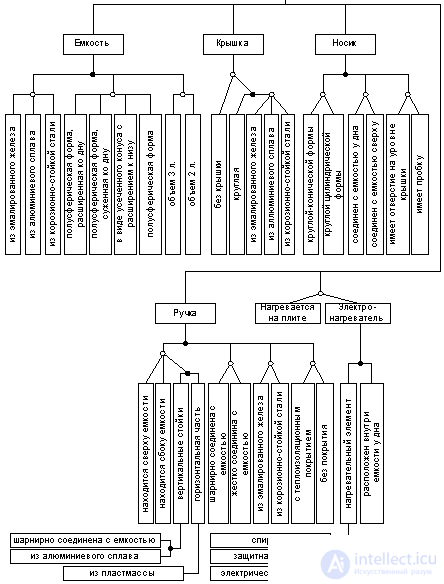Lecture
So, let us assume that there is a universal knowledge representation tool. Consider the question - how to automate the design. One of the approaches known for a long time is morphological analysis and synthesis. | |||||||||||||||||||||||||||||||||
The morphological machine was known in antiquity and was a set of concentric circles of increasing diameter, mounted on one axis, and painted with words around the circle. By rotating the circles, it was possible to invent anything by combinations of words. | |||||||||||||||||||||||||||||||||
A systematic description of this method was carried out by F. Zwicky in the 30s of the XX century. The method consists of a tool - a morphological machine, criteria for the selection of options, an operation algorithm. | |||||||||||||||||||||||||||||||||
Morphological analysis and synthesisGroups of signs
| |||||||||||||||||||||||||||||||||
The idea of the method is as follows. For signs, specific values are chosen and, thus, a product (project) is obtained. Further, it is evaluated by criteria. Generate new. And again evaluated. You can generate a huge number of products. Repeat this procedure until an optimal solution is found. | |||||||||||||||||||||||||||||||||
Consider an example. | |||||||||||||||||||||||||||||||||
| |||||||||||||||||||||||||||||||||
From the above morphological table, you can generate 3 * 3 * 3 * 3 = 81 variant. | |||||||||||||||||||||||||||||||||
Clearly, the options are represented by a morphological tree: | |||||||||||||||||||||||||||||||||
 fig.7.1 | |||||||||||||||||||||||||||||||||
In this AND-OR-tree, the black circles denote the AND nodes, the white ones - OR. | |||||||||||||||||||||||||||||||||
After creating a morphological table, in order to find the optimal solution, it is required to generate a list of requirements consisting of mandatory requirements (restrictions) and additional requirements (criteria). | |||||||||||||||||||||||||||||||||
The next stage is the folding of indicators. Only "AND" requirements are subject to collapse. You can roll in various ways: | |||||||||||||||||||||||||||||||||
Algorithm of morphological synthesis1) Narrowing the scope of the search due to dissatisfaction requirements1) Selects the requirements for which the convolution type is the same in all vertices 2) Check the vertices selected in the first step for compliance. If requirements are not met, the vertex is marked as deleted. 3) Enumerating all the vertices from the leaves to the root and checking the two rules: if we have the vertex "I", and one of the receivers is marked as deleted, then it is marked as remote; if the vertex is "OR" and all receivers are remote, then the vertex is marked as remote 2) Enumerate options and compare indicators 1) Calculate one of the subtrees 2) Is among the generated subtrees such which will have the best set of criteria | |||||||||||||||||||||||||||||||||
For the use of morphological synthesis, much preparatory work must be carried out. In addition, busting a tree may not lead to a result or give an obvious solution. The advantage of the method is its high automatization. |
Comments
To leave a comment
Artificial Intelligence
Terms: Artificial Intelligence